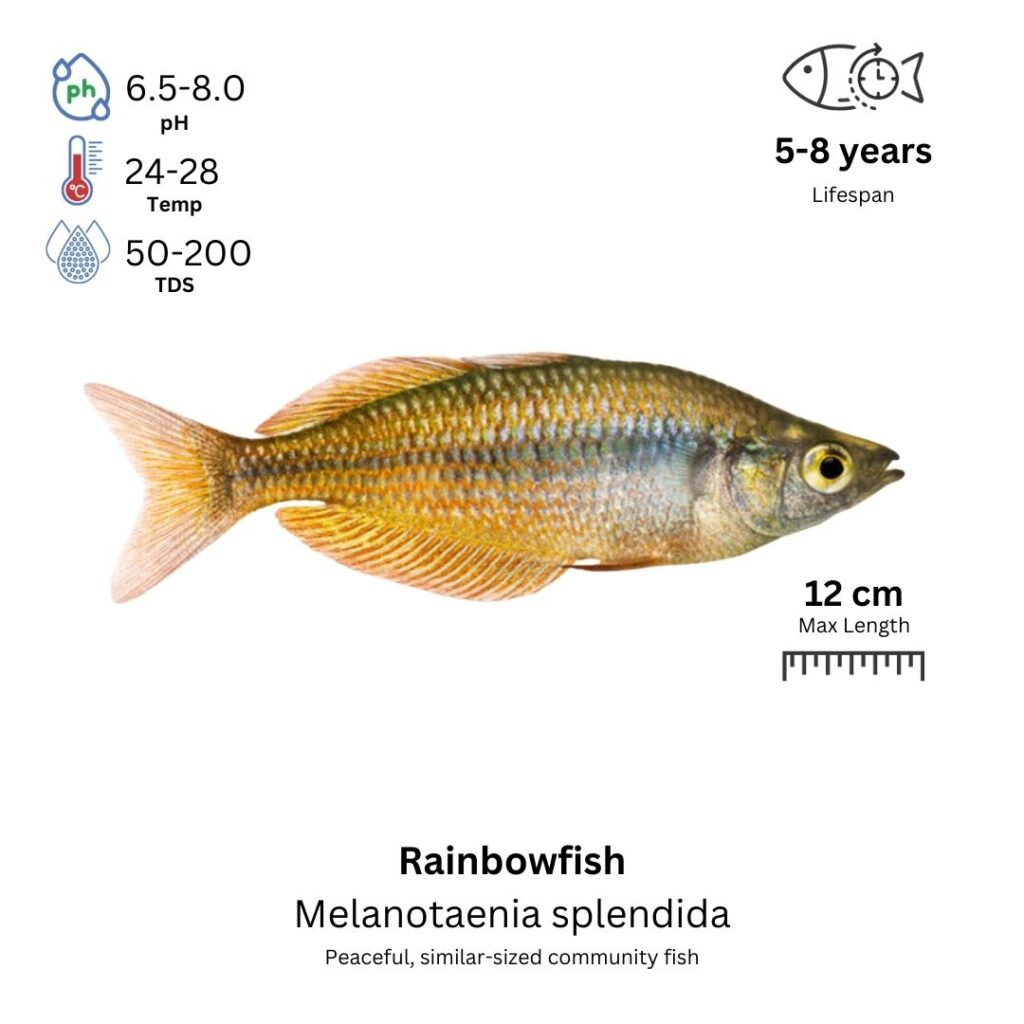Rainbowfish
Melanotaenia spp.

Description
Rainbowfish are a group of colorful and active fish species known for their vibrant, metallic coloration that can range from bright reds, blues, greens, yellows, and even purples, depending on the species. The most notable characteristic of rainbowfish is their ability to change colors based on environmental conditions, mood, and breeding. The males are typically more colorful than females, especially during the breeding season. Their bodies are streamlined and elongated, making them swift swimmers. Rainbowfish are peaceful, social fish that thrive in schools, and they are often seen darting around the aquarium in coordinated movements, displaying their full range of colors. They are active throughout the day but are not overly aggressive toward other tankmates.
Habitat Origin
Rainbowfish are native to the freshwater streams, rivers, and lakes of Australia, New Guinea, and parts of Southeast Asia. They prefer clear, warm waters with moderate flow, often in environments with aquatic plants and submerged rocks. These fish thrive in environments where water quality is stable, and they are adaptable to a range of conditions, although they do best in well-maintained aquariums with good filtration and clean water.
Aquarium
Ideal Number in Aquarium: At least 6 individuals, as they are schooling fish and feel more secure in groups.
Favorite Food

Rainbowfish are omnivores and will accept a variety of foods. They can be fed high-quality flake food, micro pellets, live or frozen foods like brine shrimp, daphnia, and bloodworms. They also enjoy grazing on plant matter and algae, so supplementing their diet with small amounts of vegetable matter like spinach or zucchini is beneficial. A varied diet helps maintain their vibrant colors and promotes their overall health.
Behavior:
Rainbowfish are peaceful and active fish that thrive in schools, often seen swimming in tight groups. They are not aggressive and are ideal for community aquariums with other peaceful species. Rainbowfish are best kept with other schooling species of similar size, as they feel more secure in groups. Although they are not overly aggressive, males can sometimes show competitive behavior toward each other during breeding periods, especially in confined spaces. They are best housed in tanks with ample swimming space and plenty of hiding spots for smaller, shyer tankmates.
Special Care:
Rainbowfish are relatively hardy, but they thrive in stable water conditions. Maintaining a well-filtered aquarium with regular water changes is important for their long-term health. They also prefer slightly acidic to neutral water, so water parameters should be monitored closely. Providing a tank with plenty of plants, rocks, and open swimming areas is essential for their well-being. They are also adaptable to a variety of water conditions, but they do best in environments that replicate their natural habitat, with warm, clean water.
Compatibility with Other Fish:
Yes, rainbowfish are compatible with many peaceful species. They can be housed with other small to medium-sized fish like tetras, rasboras, peaceful catfish, and other rainbowfish species. They are also compatible with small shrimps and snails. However, they should not be kept with large or aggressive species that could pose a threat to them. Rainbowfish do well in peaceful community setups, where their colorful display adds beauty and movement to the aquarium.
Breeding Setup
It is recommended to use a separate breeding tank for Rainbowfish species such as Boesemani, Neon, or Red Rainbowfish. A dedicated tank allows better control of water parameters and protects eggs and fry from predation. A 100-liter (26-gallon) tank is ideal for a pair or small group, while larger tanks are beneficial for multiple pairs or more plants and hiding spots. Maintain water conditions with a pH of 6.5 to 7.5, temperature between 24°C to 28°C, and hardness (GH) of 5 to 15 dGH. Use a gentle sponge or internal filter with low flow to ensure calm water. Provide a fine substrate like sand or smooth gravel, and add live plants such as Java moss, Hornwort, or Anubias for egg attachment and shelter. Floating plants like duckweed offer shaded areas, mimicking their natural habitat. Moderate lighting that replicates natural conditions is ideal.
Conditioning for Breedingc
Condition Rainbowfish with a varied, protein-rich diet including high-quality flakes, live foods like brine shrimp, daphnia, bloodworms, and frozen foods such as mysis shrimp. This diet helps prepare males and females for spawning. Maintain optimal water quality with regular 25% weekly water changes to reduce waste buildup and stress, ensuring the fish are healthy and ready.
Spawning
Rainbowfish are egg-scatterers. During spawning, males court females by displaying bright colors and courtship dances. Females scatter sticky eggs on plants, rocks, or glass, which males fertilize afterward. Females can lay 50 to 200 eggs depending on species. After spawning, remove adults to prevent egg predation, as Rainbowfish typically do not guard their eggs.
Fry Care
Eggs hatch in 24 to 48 hours, depending on temperature. Fry rely on their yolk sacs initially before becoming free-swimming. Feed free-swimming fry infusoria, liquid fry food, or microscopic live foods like rotifers. After several days, introduce baby brine shrimp or microscopic algae, progressing to finely crushed flakes or small pellets as they grow. Maintain clean water with daily 10-15% water changes, stable temperatures between 24°C and 28°C, and closely monitor ammonia, nitrite, and nitrate levels.
Important Notes
Rainbowfish reach sexual maturity between 6 to 12 months. Males are generally smaller, slimmer, and more vibrantly colored, especially during breeding, while females tend to be larger, rounder, and less colorful, especially when gravid. Avoid stress by maintaining stable water parameters, avoiding overcrowding, and keeping a peaceful environment free of aggressive tankmates. Rapid changes or poor water quality can negatively impact breeding success.
